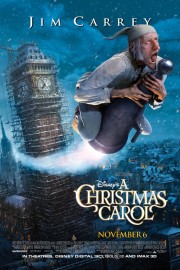A Christmas Carol
In another five years time, don’t be surprised if we’re talking about this new “performance capture” animation with the same awe and reverence we associate with the Pixar masterpieces, or the gems of Aardman and Henry Selick.
With his third successive effort in the medium, Robert Zemeckis- following 2004’s “The Polar Express” and 2007’s “Beowulf”- is moving closer and closer to perfecting this new brand of animation. The movements are a little more fluid. The eyes and faces a little more expressive. And the story, well, you can do worse than Charles Dickens’ classic tale (which I won’t recount here- I’m sure you already know it by heart) for source material. Zemeckis- as writer and director- makes it come alive in ways no one else has.
Well, Zemeckis and Jim Carrey, whose physical assets as a performer are ideally suited to take on the multiple roles this medium allows. In addition to the grumbling and frail visage of Ebenezer Scrooge, Carrey also plays the Ghosts of Christmas Past, Present, and Future. Zemeckis’ vision of the spirits is original and- especially when it comes to the Ghost of Christmas Future- genuinely haunting, as is the Ghost of Jacob Marley, Scrooge’s old partner who passed away seven years before on Christmas Eve. Carrey is asked to do more here than previous actors have in Zemeckis’ other mo-cap epics, and he seems freer here than he has in years…maybe because in the end, the possibilities are endless.
But the film’s accomplishment, and Zemeckis’, is in the film’s look as a whole. In “Polar Express,” the animation’s darker edges seemed too frightening and cold for the otherwise cheerful material, but better suited for the mythic world of “Beowulf.” “A Christmas Carol” finds a beautiful middle ground. The camera is free to soar over 19th Century England, and while the lighting can be joyfully festive in flashes of childhood happiness or on the climactic Christmas Day (with Scrooge’s soul renewed), Zemeckis has unparalleled freedom to take the audience (and his characters) into a truly scary visual place, like when a ghost carriage chases Scrooge through the London streets.
His use of 3-D to enhance the experience helps in the film’s visual impact. Unfortunately, I missed “The Polar Express” in IMAX 3-D, but having seen both “Beowulf” and now “A Christmas Carol” that way, one can see a master use the technique in ways that make it worthwhile to put those damn glasses on. More than just throwing things at the audience, Zemeckis uses it to emerge us in the world onscreen, and enrich the story’s emotional impact.
We’re in an exciting new era of film. 3-D is here to stay (although not enough people are using it right), as is mo-cap animation (have I mentioned that I can’t wait for Spielberg’s “Tintin” film in 2011?). Now it’s time to take that next step. James Cameron is promising it with “Avatar,” but Zemeckis is already ahead of the curve. Each of his efforts in the medium has grown more assured aesthetically, and more freeing visually (“Carol” is among his best films period). Hollywood should be warned, however- Zemeckis and Cameron aren’t out to replace the modern ways of filmmaking but enhance them. This is a new way of storytelling, not a threat to the status quo. This is what “Final Fantasy: The Spirits Within” sought to do, but failed. If only they’d waited a few years so that they could get it right.










